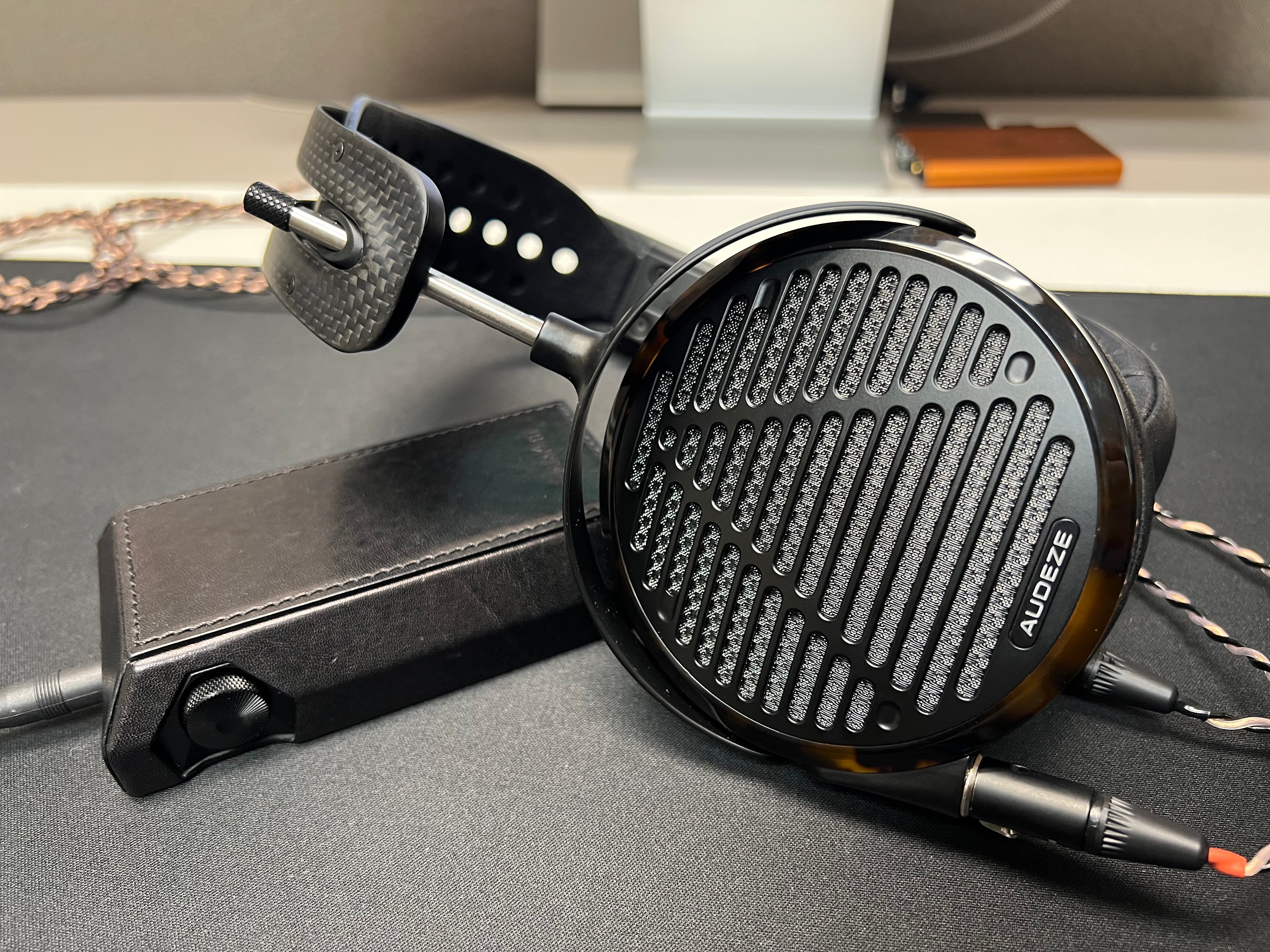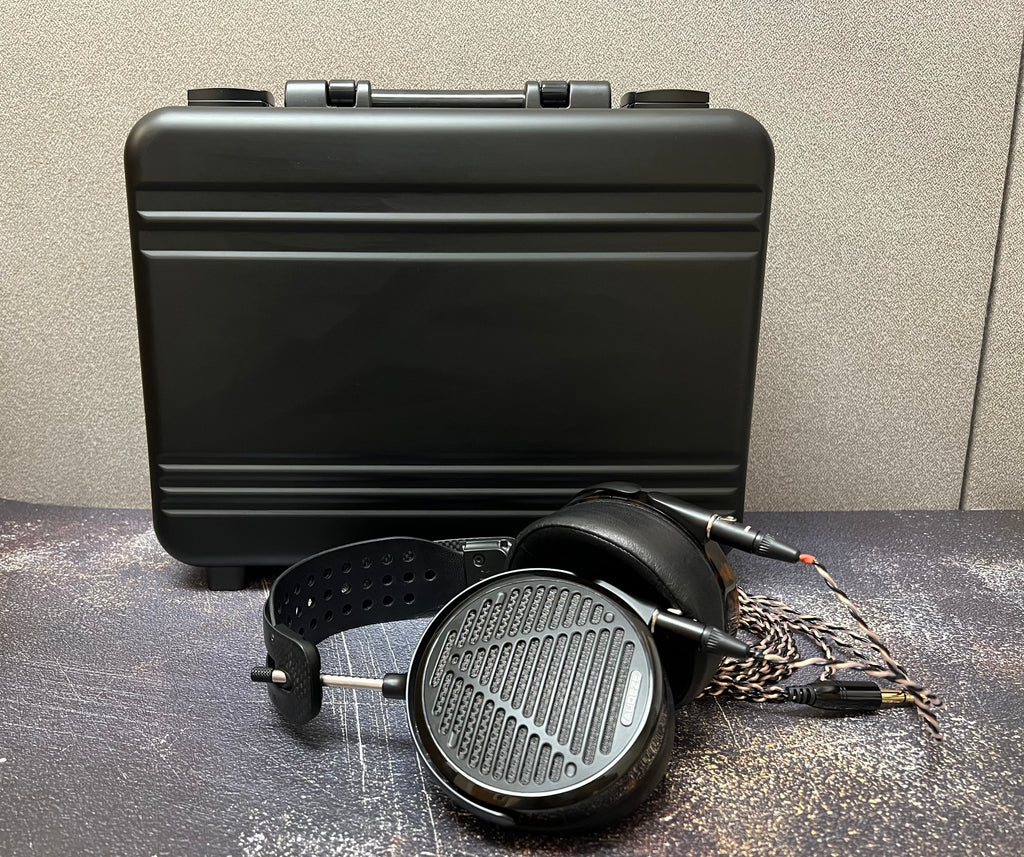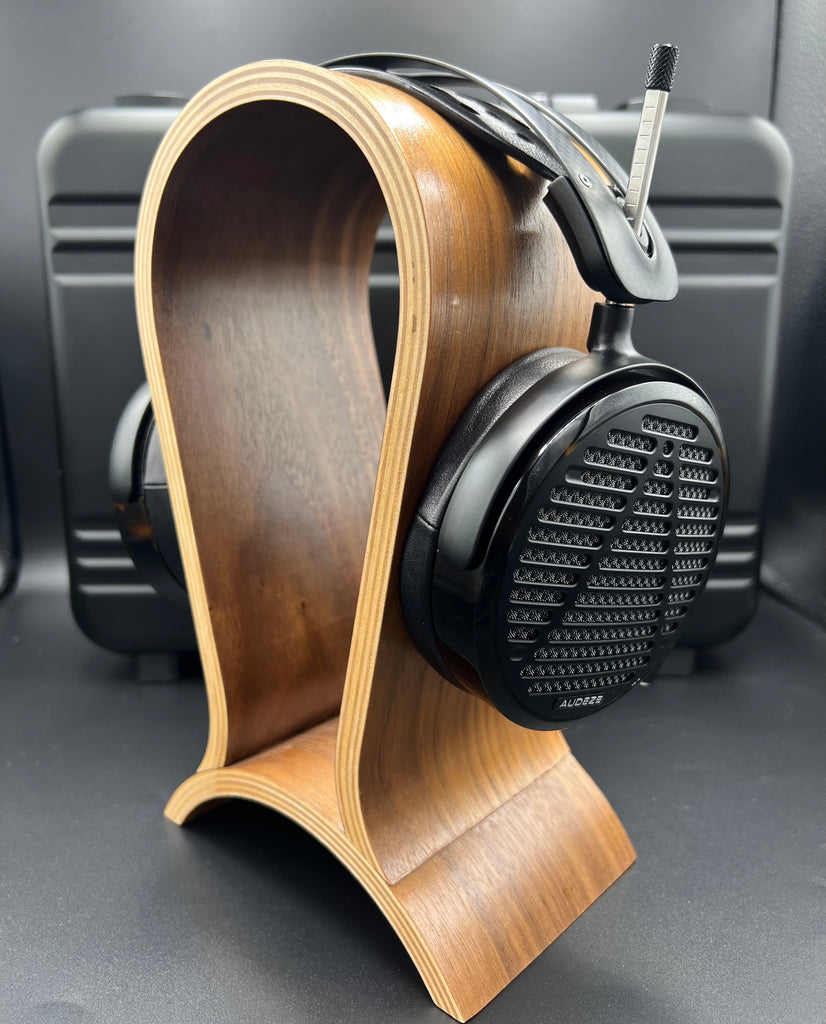It’s been six years since Audeze launched the LCD-4, and while there have been a couple revisions to the design since then, it’s largely remained the same great headphone. Enter LCD-5. Where LCD-4 was the culmination of all things Audeze up until that point – with a look and feel that’s very close to the original 2009 LCD-2 – LCD-5 brings a fresh design, and a host of design changes to usher in a new generation of Audeze headphones.
Build and Design
Audeze’s LCD series has a very recognizable design language: a mix of metal, wood, and leather molded into big headphones that seems to engulf your entire head – along with weighing it down quite a bit – in the process of pumping exquisite sound through huge drivers to your eardrums. LCD-5 has some of that, but it’s lighter, tighter, and more refined. The earpads shave off some of the cushy, oversized feel of the previous models; the earcup design is slimmer, with less feeling of excess bulk; and the headband has been refined, with some weight shaved off. Another design change is the new look, which is a more streamlined sleeker version of the iconic Audeze design we’ve all come to love.
The final result of all this is a headphone that not only looks great, but feels lighter, less fatiguing to wear, and is overall much more comfortable than its predecessors. While the weight has been cut and the overall comfort is largely improved, the clamp force has been increased. So while it’s generally more comfortable with a smaller footprint on your head, the clamp force may counter some of the improvements especially if you have a larger head.
The package is solid with a little bit of Audeze’s typical flagship fanfare. That is, you get the headphones, a premium cable, a case, and a pair of white gloves for handling the headphones – so as to not create any unnecessary smudges and prevent other sorts of minor damage from handling the headphones [but really it’s a tongue-in-cheek way of Audeze saying “these headphones are worth a ton of money”]. The case is black with a metal exterior, not quite as protective as the flight case that comes with some other models, but smaller and more aesthetically pleasing.
The Sound
LCD-5 starts with a largely neutral sound signature, and provides deep subbass extension, and just a hint of emphasis in the upper end. Overall it’s a neutral reference-like tuning, but there’s more to the sound than just the tonality. What LCD-5 provides is a sense of physicality to the presentation that gives it a sense of realism which creates a high level of engagement without having to sacrifice accuracy.
In terms of its tonality, the bass is thick and deep with subbass extension that goes all the way down, and a midbass that provides slam and a dynamic feeling when the music delivers it, but doesn’t emphasize bass that isn’t there or bleed into the mids.
Speaking of the mids, the LCD-5 mids are a big highlight. The instruments and vocals are clear, well placed in the mix with a natural timbre that lends to the overall sense of realism. There is very strong texture with a sense of body, weight, and presence. The detail retrieval is among the best, with stunning levels of layered intricacies on display in recordings.
As you move into the treble, you can hear strong definition and instrument separation. The resolution is also very strong, with lightning fast attack and a smooth, natural decay. There’s a taste of air, but the treble extension isn’t particularly strong. LCD-5 largely avoids sibilance or harshness with the emphasis and cuts in the treble being dialed in nicely.
The soundstage on the LCD-5 is wide and fairly well rounded in terms of depth and height, but not quite as large as some other flagship headphones. What it does provide is an honest accurate representation of space as well as incredible imaging. The strong positioning within the 3D image combines with the body and weight of the mids to provide a transcendent sense of the physical presence of instruments and performers.
Another thing that’s notable about the LCD-5 is that it has much better efficiency than Audeze’s previous flagship models. While the recommended power level for the LCD-4 was 500mW at 200 ohms, Audeze’s recommendation for the LCD-5 is 250mW at 15 ohms. This is a major drop that means that you can unlock LCD-5’s slam and dynamics on a much wider range of portable and desktop products.
Close your eyes while listening to “Wish You Were Here” by Pink Floyd, and David Gilmour is a few feet in front of you strumming his guitar. When the rest of the band comes in, the intimate soundstage widens to present the whole band around him on stage. LCD-5 deftly moves with the recording, shifting the feeling from up close and personal in your living room to ten rows back at Royal Albert Hall. The levels and positioning are all perfect, with voices and instruments being balanced with a strong, well defined presence and position.
Trivium, as a band, is capable of a level of power mixed with speed that can leave lesser headphones and sound systems in the dust. On “In the Court of the Dragon” they deliver punishingly fast drum fills, blended with acrobatic bass playing and tight chugging guitars. On so many headphones this turned into so much bloat and mud. However, LCD-5’s drivers can perform their own acrobatics, capturing the impact of each drum hit along with the texture and energy of the guitar and bass. The speed of LCD-5 is also apparent in how cleanly it resolves the emphasis of each brutal hit from the bottom end of the bass to the crash of the cymbals at the top.
Tori Amos’s “A Sorta Fairytale” opens with a drum groove that LCD-5 delivers with texture and just the right level of physicality to match the mood of the song. Amos’s vocals are nuanced and detailed, with emotion and a personal, intimate feeling. The band is nicely layered. No instrument or performance is a strong standout, but LCD-5 delivers the balanced and interplay of skilled musicians adding just the right amount of nuance and personality to a low key performance.
The opening piano arpeggios of Hiromi’s “Uncertainty” have a soft delivery punctuated by a slow build of sharper chords and melody above them. LCD-5 puts you in a concert hall with a piano at the center, but in a surreal fashion, you’re both far enough back to feel the reverberations of the room around you, and close enough to feel the percussive striking of fingers against keys. The piano is at once warm and smooth but also cold and sharp. The level of detail combined with the presentation of the 3D image is completely transportive.
Comparison: Meze Elite, HIFIMAN Susvara
As there have been a number of new flagship headphones released recently, there’s a lot of fresh buzz in the discussion of $4000+ headphones. In addition to the newcomers, like the Stealth, LCD-5, and Meze Elite, the HIFIMAN Susvara always looms large in the conversation. For this review, we compared the LCD-5 with fellow open back flagship headphones Meze Elite and HIFIMAN Susvara. While each had some similar characteristics, there were a couple defining differences that should help you decide which is the best for you.
In terms of build, Meze and Audeze have a much stronger level of perceived quality, with higher quality materials and a sturdier feel overall. The look itself is somewhat subjective though I could see LCD-5 having the broadest appeal with its update on the iconic LCD series design. In terms of comfort, there’s really no beating Meze. Elite simply melts onto your head, and while Audeze made some major improvements in the LCD-5 over the LCD-4 in the weight and overall comfort department, I still found it to be the least comfortable of the three for long term wear, largely due to the strong clamping force.
In the bass, Elite delivers tighter slam that comes faster and easier than Susvara, which has a thicker broader feel to the hits in the bass that require quite a bit more power to coax out. LCD-5 is a combination of both: it’s easier to drive than Susvara, but not as easy as Elite, and the slam leans more towards Susvara’s broad thick feeling than the lighter, tighter punch of Elite. Elite also doesn’t quite extend in the same linear manner as Susvara and LCD-5 and so doesn’t reach the same depths of bass.
The mids are similarly strong for Elite and LCD-5. Both have a weighty natural feel with acoustic instruments and strong placement of the vocals, where Susvara sounds good, but doesn’t match these two where they’re strongest. Moving into the treble, LCD-5 has the smoothest treble of the three, but also the least air and sparkly. Susvara has the strongest resolution, with LCD-5 being a close second.
Susvara, as expected, has the most expansive soundstage, with Elite’s being similarly constructed but with a slightly lessened sense of space around the listener. LCD-5’s soundstage feels smaller, but that sense of presence and weight in instruments and vocals gives the imaging a level of realism that elevates it above the rest of the pack.
Other than the sound and comfort, the main constraints around picking one of these three headphones would be how you intend to use it. Elite is the best of the three for low power sources and mobile use. Susvara is well known for requiring excessive amounts of power to get the best performance. LCD-5 lands in between. It certainly appreciated having Burson Conductor 3X Reference levels of power, but also sounded great with the unbalanced output of a KANN Alpha. So depending on your design preferences, setup, and lifestyle any of these three could be the best flagship headphones for you.
The Bottom Line
LCD-5 is a big step forward for Audeze on a number of fronts. It’s lighter and more comfortable than its predecessors along with having a smooth, sleek visual design. From a technical standpoint, it’s more efficient, opening up more options for enjoying flagship level sound quality, and it’s tuned to provide a more refined take on the classic Audeze sound with incredible depth and transparency. Basically, LCD-5 is a masterclass on evolving a beloved flagship product: Audeze maintained its core values while taking its design and performance to the next level.









